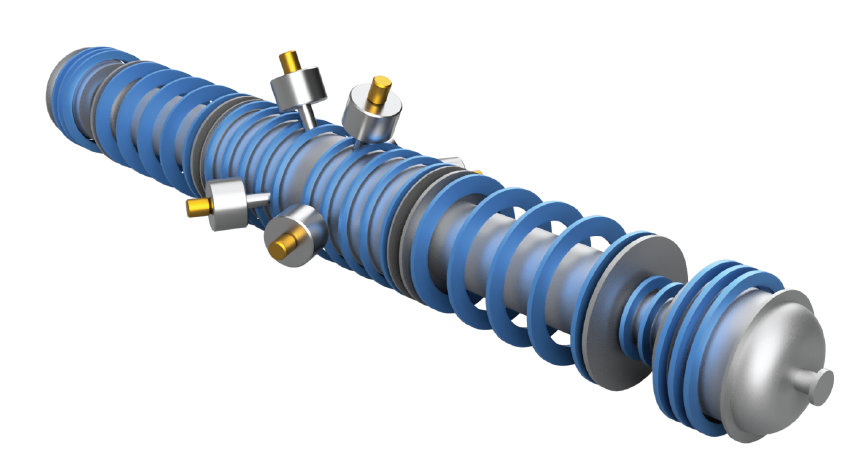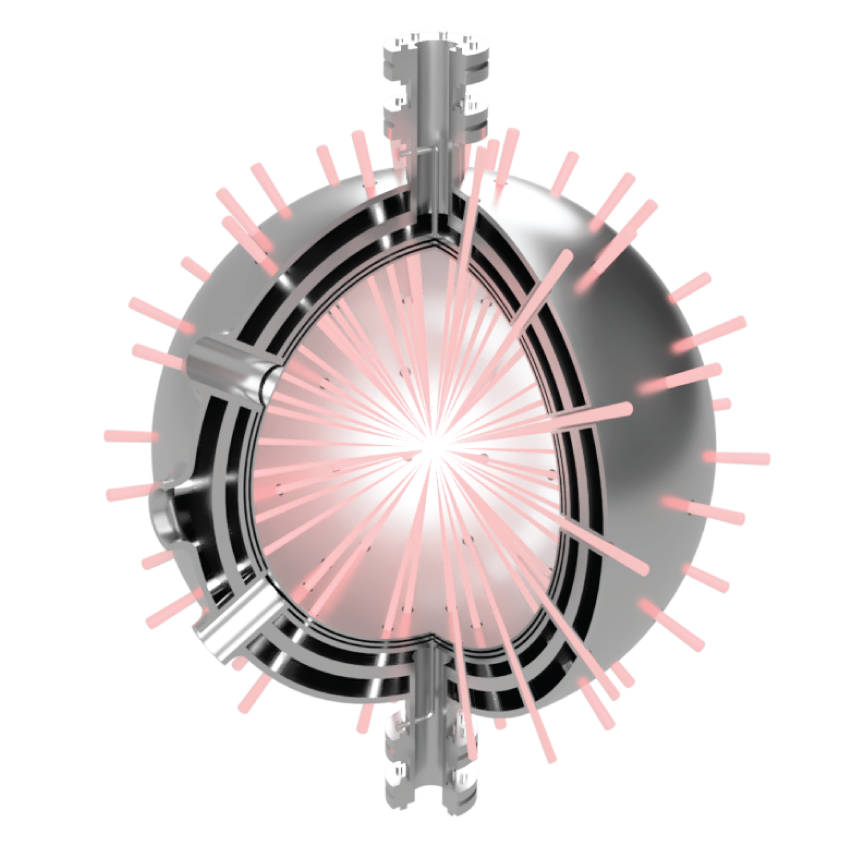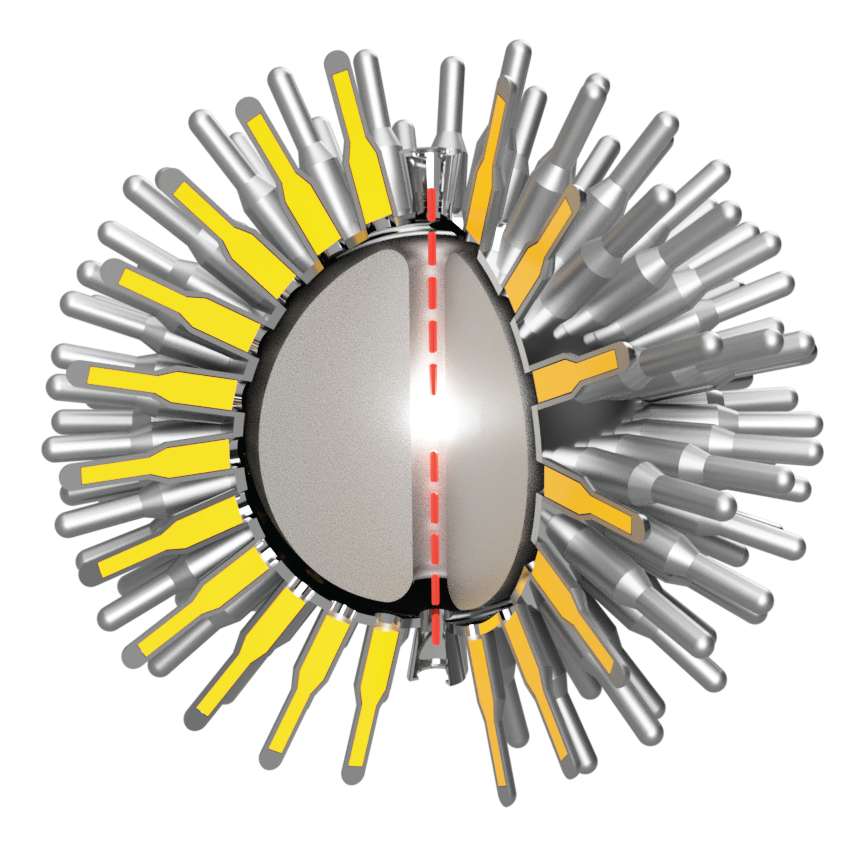MCF
Magnetic Confinement Fusion
The most famous embodiment of an MCF device is a tokamak–a powerful electromagnetic fields combine with electrical current flowing directly through the plasma to heat and confine the toroidal plasma. The word “tokamak” is a Russian acronym for “toroidal chamber with axial magnetic field”.
- History.
- More than 200 tokamaks have been built since the 1960’s, the largest and most ambitious of which is the ~$25 Billion ITER project still being constructed in southern France. Despite being proposed in 1985, ITER is not projected to be operational until 2035. Recently, new high-temperature superconducting materials such as yttrium-barium-coper oxides are promising to make magnetic confinement more feasible.
- Challenges.
- Tokamaks require extremely strong magnets in the 3 to 20 Tesla range which also require high tolerances. Imperfections in the magnetic confinement lead to large scale disruptions in the plasma, loss of confinement and serious damage to the reactor. Magnetic confinement of hot plasma ions does nothing to remove the large number of neutral atoms within the reactor, all of which rob the plasma of fusion energy making net energy generation more difficult. The sheer scale, complexity and tolerances required to achieve reliable confinement are also a challenge.
- Notable Projects.
- Commonwealth Fusion Systems, Tokamak Energy, ITER, CTFusion, JET

FRC
Field-Reversed Configuration
FRC devices form self-stable toroidal plasmas similar in form to a smoke ring. A toroidal current is induced inside of a cylindrical plasma, forming a poloidal magnetic field which is reversed with respect to the direction of an externally applied magnetic field. In some FRC devices, such as shown, self-stable toroidal plasmas are then collided at the center of a linear chamber. The resulting toroid can be further stabilized by a variety of methods including neutral beams.

- FRCs were first studied at the US Naval Research Laboratory (NRL) in the 1960s and subsequently at Los Alamos National Laboratory and the Redmond Plasma Physics Lab at University of Washington resulting in over 600 related publications. Private companies in California and Washington State have continued the research in 1998 and 2013 respectively.
- While FRC’s self-stable plasma toroids are less prone to instabilities than some magnetic-confinement techniques, sufficient plasma densities and stabilities have continued to elude scientists despite decades of testing.
- Helion, TAE Technologies
- History
- Challenges
- Notable Projects
ICF
Inertial Confinement Fusion
Dozens to hundreds of extremely powerful pulsed lasers or ion beams focus their energy on a small fusion fuel pellet, compressing it rapidly. The resulting shock wave within the pellet heats up the plasma faster than it can radiate it away.
- History.
- Inertial confinement was first proposed in the 1960s, and the first large-scale ICF devices didn’t start operation until the late 70’s. The largest and most notable ICF device is the National Ignition Facility, which started construction in 1997.
- Challenges.
- Laser-plasma instabilities produce high-energy electrons which transport much of the energy and fusion fuel before it can fuse. Practical extraction of heat from the reaction chamber walls without interfering with the many laser penetrations has not been solved. Additionally, the removal of fusion ash and the remains of the previous fusion pellet from the inside inside of the chamber for successive pulsed shots is difficult. The high cost and complexity of the lasers (not shown) make traditional ICF devices uneconomical for energy production as well.
- Notable Projects.
- General Atomics, First Light Fusion, Marvel Fusion

MTF
Magnetized Target Fusion
A hybrid approach to fusion, MTF uses a magnetic field to confine a low-density plasma (like an MCF device), while surrounding the plasma with an (often liquid) metal liner. The metal liner is then heated and compressed using inertial-confinement techniques such as lasers, or pistons. While plasma densities are significantly lower than most ICF machines, the theory is that the longer confinement times and better heat retention will allow MTF devices to produce comparable power levels and will be easier to build.
- History.
- The first MTF device was built by the US Naval Research Laboratory (NRL) starting in 1971. It utilized mechanical compression of a solid metal liner, however liner cost and replacement made the reactor impractical and subsequent designs address the problem with spinning molten metal liners. NRL’s Linus program was eventually cancelled due to a variety of engineering challenges. The method was revitalized in 2002 by General Fusion.
- Challenges.
- There are a variety of engineering challenges to overcome including plasma preparation and injection methods, magnetic flux diffusion in the molten liner, removal of vaporized liner material between fusion pulse cycles, axial plasma losses during compressions, and achieving high tolerance piston synchronicity.
- Notable Projects.
- General Fusion, Magneto-Inertial Fusion Technologies, HyperJet Fusion

Orbitron
High speed ions are electrostatically confined in precessing elliptical orbits around a negatively charged cathode. The ion density is increased by the co-confinement of high temperature electrons trapped by an external weak magnetic field perpendicular to the electrostatic field in a “crossed field” configuration similar to a magnetron microwave device. Crossing elliptical paths of ions provide millions of chances of fusion-relevant collisions before the ion loses energy and is moved out of the interaction space as it falls into the cathode and is removed from the chamber.
See The Orbitron- History.
- The Orbitron configuration was invented in 2020 and is under development in Washington State.
- Challenges.
- The interaction space for Orbitron plasma is extremely small for fusion devices, and requires extremely high voltages to trap the ions at fusion relevant speeds. Managing dielectric breakdown and flashover in such a small space is an engineering challenge, and the plasma interactions for glancing beam-beam configurations are not well understood.
- Notable Projects.
- Avalanche Energy

